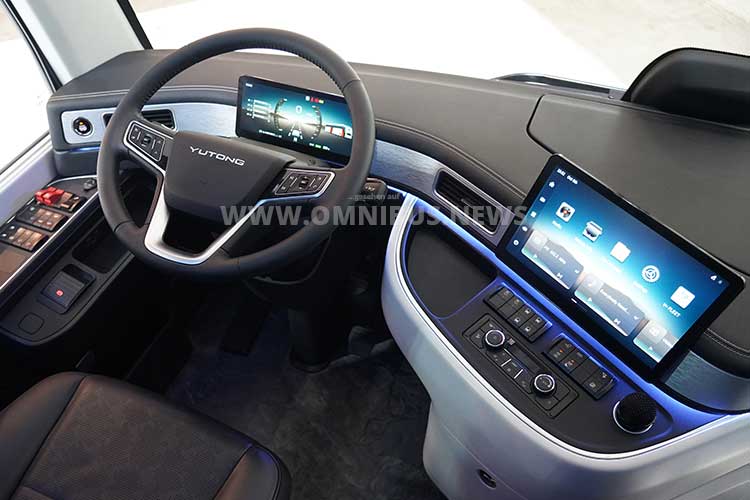
Der Fahrerarbeitsplatz im BEV-Reisebus T15E von Yutong. The driver’s workplace in the T15E BEV coach from Yutong. Foto/photo: Schreiber
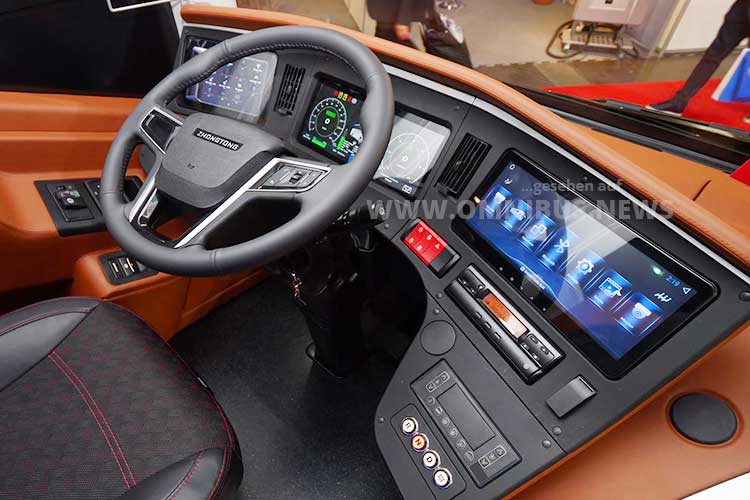
Der Fahrerarbeitsplatz im BEV-Reisebus H12 von Zhongtong. The driver’s workplace in the 12 BEV coach from Zhongtong. Foto/photo: Wagner
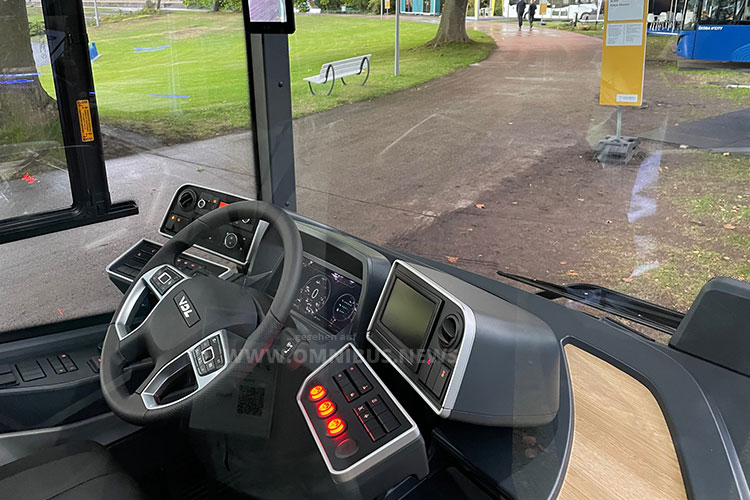
Der Fahrerarbeitsplatz in der neuen Citea-Generation setzt Maßstäbe. The driver’s workplace in the new VDL Citea generation is now setting standards in the city bus sector. Foto/photo: Schreiber
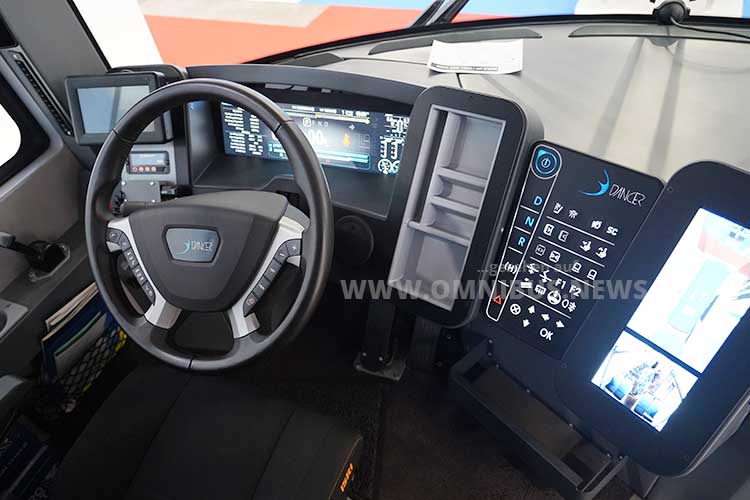
Auch beim Fahrerarbeitsplatz geht man bei Dancer Bus eigene Wege. Dancer Bus also goes its own way when it comes to the driver’s workplace. Foto/photo: Schreiber
Busworld is not only the industry’s most important trade fair format and exchange, but also a place to discover trends. This year, anyone who followed the eight-kilometre red carpet of the Expositiehallen van Brussel or Paleizen van de Heizel with open eyes could discover buttonless cockpits as a trend with a view to design.
The world of buses and coaches thrives on change, no question about it. Not only did the first battery-electric coaches come to Brussels from Asia, but also the trend towards a minimalist driver’s workplace (at least with regard to the traditional round instruments and switches or buttons).
Artificial intelligence has not yet moved into the cockpit of the future, but we use a corresponding lever for the indicator. For the time being, because today AI can already set the indicator independently because algorithms successfully calculate where the bus driver is most likely to want to turn next. What is possible in the field of passenger cars will also reach the world of commercial vehicles in the near future.
The cockpit of the future in a bus combines opulence and minimalism, if one follows the offers from Asia. The model in a figurative sense could be the dragon, which has positive connotations in China, where a voluminous head is followed by a slender body. What does this mean for the cockpit? The minimal number of monitors in the cockpit of the future offer a wide range of possibilities. Everything can be displayed that the bus driver seems to need in terms of information for driving.Electronic switch panels instead of mechanical switches, clear displays instead of analogue displays and instruments. This is what the future will look like.
The trend was probably triggered by autonomous driving. Designers were able to sketch their ideas of what a vehicle’s interior will look like when the classic combustion engine and all its components are eliminated. Other perspectives are permitted, and electric bus manufacturers have sometimes rethought the vehicle from the ground up. Much more space for the driver (and passengers) is the credo. Even if the BEV coaches shown at Busworld are not yet autonomous, the respective cockpits follow a trend towards visual minimalism in a (bus) world that is more than ever flooded with stimuli. The Chinese bus manufacturers such as Yutong or Zhongtong can also do things differently, as their cockpits in the BEV coaches showed.
But not only that, Dancer Bus from Lithuania has found its own very individual approach for the cockpit of the electric bus. And VDL from the Netherlands has already come up with its own cockpit for the new electric bus. And even the supplier industry has said goodbye to the legendary VÖV banana, the standardised cockpit – at least for the segment of city buses (according to the guidelines of the Association of German Transport Companies (VDV)) will probably no longer be accepted in the future.
With a new look, new (digital) instrumentation and a high degree of variability, it is heading into the future. The VDV workplace was factual, clear and ergonomically mature. But not emotional enough, the bus driver deserves more. Continental has developed a modular driver’s workplace which, according to the supplier to the commercial vehicle industry, is as individual as the demands of its users.
With freely configurable control panels and optional panels for further functions, the modular driver’s workplace can be flexibly configured for use in regular-service buses and coaches. Ergonomics and comfort make work easier, clarity and a simple operating concept make driving more productive and also safer.
In the mid-nineties, the standardisation of scheduled buses came to an end in Germany. Mixed fleets and the constant change of drivers remained, and the VDV workplace was born. Uniform dimensions, economical instrumentation and the defined distribution of switches made the bus driver’s everyday life easier. For too long, however, people stuck to what they were used to; a digital display in the classic cockpit was already presented in this country as a groundbreaking innovation.
That is not enough; the bus world and the bus driver deserve more. In the digital age, things are now minimalist and opulent: where the speed, charge level or navigation is displayed on the monitor in the cockpit when driving, the bus stop information is displayed on the monitor in the cockpit when stopping.
And when reversing or for the all-round camera systems, the display can be used as a monitor, making another screen superfluous.Congratulations, there you go, one would like to shout to the courageous manufacturers of new cockpits! The minimalism of the components is explained. Opulence becomes apparent when warning lights only appear on the display when there are malfunction messages. Presented on the surface at the right time from the depths of the rich information offerings, that’s how it should or must be.
In addition, pop-up messages can be shown to warn the bus driver in exceptional situations. Whereas in the past it was just a yellow or even red light, in future it will be an icon, a small symbol, which provides important information supplemented with little text. This is somehow reminiscent of a master of his trade, German designer Dieter Rams said: „Good design means as little design as possible“.
True: Buttonless, but not headless, is how the cockpit of the future presents itself. And what else was new to discover in Brussels at Busworld with regard to design? The superstructures of the city buses have become and are becoming higher – in other words, the proportion (glass to sheet metal) is shifting. The black paint below the side windows is often used as a stylistic balancing element. Finally, the traditional engine tower at the rear of the city bus is history. However, few manufacturers still hold on to this relic. When the engine tower has disappeared, horizontal layering in the exterior is formally possible, as designer Mathias Lenz explains in conversation with omnibus.news.
The creative mind, who once designed buses for Daimler Buses and Yutong, sees potential for corner glazing. This is already evident in the new intercity series from Ulm, even if it has not yet been realised.And of course the topic of aerodynamics is more central than ever when it comes to BEV or FCEV coaches of the future. The first manufacturers are already exploiting the potential of the lateral retraction at the rear, as could be seen at Busworld. And VDL is also preparing something exciting for the next generation of the Futura, which will be presented in 2024… Chinese suppliers such as Yutong or Zhongtong are already at Busworld with a BEV coach, although there is neither a corresponding charging concept nor the necessary periphery for Europe. But: With the buses on display, they show that they can also serve the segment.
And which (design) trend can be seen in its entirety among the Asians? And what (design) trend can be discerned among the Asians as a whole? For the most part, the buses at Busworld were more convincing than ever with good material appeal and formally well thought-out solutions. Yutong has taken the European market into consideration and was rightly awarded the Busworld Design Award. Other Chinese manufacturers are also getting to grips with the European market and exploring its visual requirements.And they are succeeding more and more, as could be seen at Busworld 2023. (Rüdiger Schreiber/omnibus.news)
DEUTSCHE FASSUNG
Die Busworld ist nicht nur das wichtigste Messeformat und der Austausch der Branche, sondern auch ein Ort, an dem Trends zu entdecken sind. Wer in diesem Jahr mit offenen Augen den acht Kilometer langen roten Teppich der Expositiehallen van Brussel bzw. Paleizen van de Heizel folgte, der konnte mit Blick auf das Design als einen Trend knopflose Cockpits entdecken.
Die Welt der Omnibusse lebt von Veränderungen, keine Frage. Aus Asien kamen nicht nur die ersten batterieelektrischen Reisebusse nach Brüssel, sondern eben auch der Trend hin zu einem minimalistischen Fahrerarbeitsplatz (zumindest mit Blick auf die traditionellen Rundinstrumente und Schalter bzw. Knöpfe).
Im Cockpit der Zukunft ist künstliche Intelligenz zwar noch nicht eingezogen, für das Blinken nutzen wir einen entsprechenden Hebel. Noch, denn heute kann KI schon selbstständig den Blinker setzen, weil Algorithmen erfolgreich berechnen, wohin der Busfahrer am wahrscheinlichsten als Nächstes abbiegen möchte. Was im Bereich der Pkw möglich ist, wird in naher Zukunft auch die Welt der Nutzfahrzeuge ereilen.
Das Cockpit der Zukunft in einem Omnibus vereint Opulenz und Minimalismus, wenn man den Angeboten aus Asien folgt. Vorbild im übertragenden Sinne könnte der in China positiv konnotierte Drache sein, dem einem voluminösen Kopf ein schlanker Körper folgt. Was heißt das für das Cockpit? Üppig die Abrufmöglichkeiten der minimal vorhandenen Monitore im Cockpit der Zukunft.
Alles kann angezeigt werden, was der Busfahrer scheinbar für das Fahren an Informationen benötigt. Elektronische Schalterfelder statt mechanischer Schalter, übersichtliche Displays statt analoger Anzeigen und Instrumente. So und nicht anders wird die Zukunft aussehen.
Ausgelöst haben dürfte den Trend das Autonomen Fahren. Designer konnten ihre Ideen skizzieren, wie ein Fahrzeug im Innenraum aussehen wird, wenn der klassische Verbrennungsmotor samt aller Komponenten wegfällt. Andere Perspektiven sind zugelassen, mitunter haben Elektrobushersteller das Fahrzeug ja auch von Grund auf neu gedacht. Viel mehr Raum für Fahrer (und Passagiere) lautet das Credo.
Auch wenn die Brüssel auf der Busworld gezeigten BEV-Reisebusse noch nicht autonom unterwegs sind, das jeweilige Cockpit folgt einem Trend zum optischen Minimalismus in einer mehr denn je reizüberfluteten (Bus-)Welt. Die chinesischen Bushersteller wie Yutong oder Zhongtong können also auch anders, wie deren Cockpits in den BEV-Reisebussen zeigten.
Aber nicht nur die, Dancer Bus aus Litauen hat eigen ganz individuellen Ansatz für das Cockpit des Elektrobusses gefunden. Und VDL aus den Niederlanden hat für den neuen Elektrobus mit dem Cockpit auch schon vorgelegt. Und selbst die Zulieferinsdutrie hat sich von der legendären VÖV-Banane verabschiedet, das standardisierte Cockpit – zumindest für das Segment der für Stadtbusse (nach der Richtlinie des Verbands Deutscher Verkehrsbetriebe (VDV)) dürfte zukünftig nicht mehr akzeptiert werden.
Mit neuer Optik, neuer (digitaler) Instrumentierung und hoher Variabilität geht es in die Zukunft. Der VDV-Arbeitsplatz war sachlich, übersichtlich und ergonomisch ausgereift. Aber zu wenig emotional, der Busfahrer verdient mehr. Continental hat einen modularen Fahrerarbeitsplatz entwickelt, der nach Aussagen des Zulieferers der Nutzfahrzeugindustrie so individuell wie die Ansprüche ihrer Benutzer sei.
Mit frei konfigurierbaren Bedienfeldern und optionalen Feldern für weitere Funktionen lässt sich der modulare Fahrerarbeitsplatz flexibel für den Einsatz in Linien- und auch Reisebussen konfigurieren. Ergonomie und Komfort machen die Arbeit leichter, Übersichtlichkeit und ein einfaches Bedienkonzept machen das Fahren produktiver und auch sicherer.
Mitte der neunziger Jahre endete in Deutschland die Standardisierung der Linienbusse. Gemischte Fuhrparks und der stete Fahrerwechsel blieben, der VDV-Arbeitsplatz wurde geboren. Einheitliche Abmessungen, eine sparsame Instrumentierung, die definierte Verteilung von Schaltern erleichterten den Alltag des Busfahrers. Zu lang hielt man aber an Gewohntem fest, eine digitale Anzeige im klassischen Cockpit wurde hierzulande schon als wegweisende Innovation präsentiert.
Das ist zu wenig, die Buswelt bzw. der Busfahrer verdient mehr. Im digitalen Zeitalter geht es nun minimalistisch und opulent zu: Wo beim Fahrbetrieb die Geschwindigkeit, der Ladestand oder die Navigation auf dem Monitor im Cockpit angezeigt wird, sind beim Haltestellenbetrieb dann – in derselben Oberfläche – die Türkameras und andere relevante Informationen zu sehen.
Und beim Rückwärtsfahren oder für die Rundumkamera-Systeme kann das Display als Monitor genutzt werden und macht einen weiteren Bildschirm überflüssig. Glückwunsch, geht doch möchte man den mutigen Herstellern neuer Cockpits zurufen! Der Minimalismus der Bauteile ist erklärt. Opulenz wird dann deutlich, wenn Warnleuchten nur dann auf dem Display erscheinen, wenn es Störmeldungen gibt. Aus den Tiefen der reichhaltigen Informationsangebote zum richtigen Zeitpunkt auf der Oberfläche präsentiert, so sollte bzw. muss es sein.
Zusätzlich können Pop-up-Meldungen eingeblendet werden, um den Busfahrer in außergewöhnlichen Situationen zu warnen. War es früher nur ein gelbes oder gar rotes Lämpchen, so ist es zukünftig ein Ikon, ein kleines Symbol, was mit wenig Text ergänzt wichtige Informationen liefert. Das erinnert irgendwie an einen Meister seines Faches: Der deutsche Designer Dieter Rams sagte: „Gutes Design bedeutet so wenig Design wie möglich“.
Stimmt: Knopflos, aber nicht kopflos präsentiert sich das Cockpit der Zukunft. Und was gab es noch in Brüssel auf der Busworld mit Blick auf das Design noch Neues zu entdecken? Die Aufbauten der Stadtbusse wurden und werden höher – sprich die Proportion (Glas zu Blech) verschiebt sich. Die schwarze Lackierung unterhalb der Seitenscheiben wird gerne als stilistisches Ausgleichselement genommen.
Endlich Geschichte ist der traditionelle Motorturm im Heck des Stadtbusses. Wobei, noch halten wenige Hersteller an diesem Relikt fest. Wenn der Motorturm verschwunden ist, dann sei eine horizontale Schichtung im Exterior formal möglich, wie der Designer Mathias Lenz im Gespräch mit omnibus.news erklärt. Der kreative Kopf, der einst Omnibusse von Daimler Buses und Yutong gestaltete, sieht Potential für eine Eckverglasung. Die deutet sich, wenn auch noch nicht endgültig realisiert, bei der neuen Überlandbaureihe aus Ulm bereits an.
Und natürlich steht das Thema der Aerodynamikmehr denn je im Mittelpunkt, wenn es um BEV- oder FCEV-Reisebusse der Zukunft geht. Erste Hersteller reizen das Potential des seitlichen Einzugs im hinteren Bereich schon heute aus, wie man auf der Busworld sehen konnte. Und auch bei VDL hat man für die nächste Generation des Futura, die 2024 vorgestellt werden wird, etwas Spannendes für den Heckbereich in Vorbereitung…
Schon jetzt sind chinesische Anbieter wie Yutong oder Zhongtong mit einem BEV-Reisebus auf der Busworld, obwohl es weder für Europa ein entsprechendes Ladekonzept und die nötige Peripherie gibt. Aber: Mit den ausgestellten Omnibussen zeigen sie, dass sie auch das Segment bedienen können.
Und welcher (Design-)Trend ist bei den Asiaten in Gänze zu erkennen? Die Omnibusse auf der Busworld überzeugten größtenteils mehr denn je durch gute Materialanmutung und formal durchdachte Lösungen. Yutong hat sich mit dem europäischen Markt auseinandergesetzt und wurde zurecht mit dem Design Award der Busworld bedacht.
Auch andere chinesische Hersteller sind dabei, sich mit dem europäischen Markt zu befassen und die optischen Bedürfnisse zu ergründen. Und das gelingt durchaus immer mehr, wie man auf der Busworld 2023 sah. (Rüdiger Schreiber/omnibus.news)
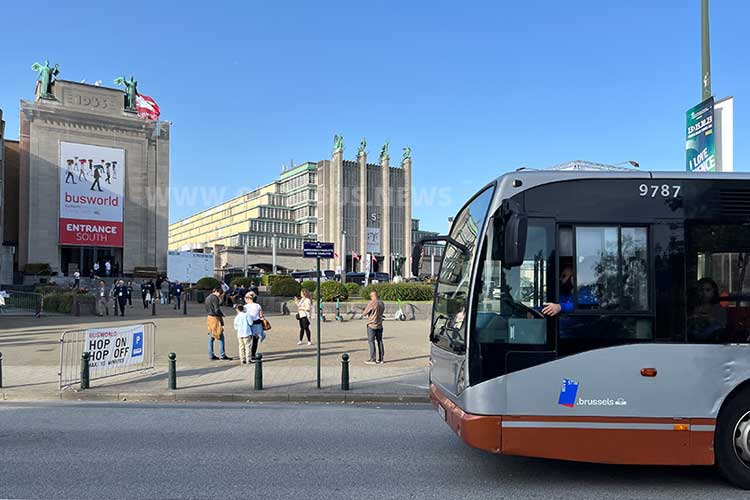
Auf der Busworld drehte sich die Welt in den Expositiehallen van Brussel bzw. Paleizen van de Heizel fast nur um Omnibusse… At Busworld, the world revolved almost exclusively around buses and coaches in the Expositiehallen van Brussel or Paleizen van de Heizel… Foto/photo: Schreiber
